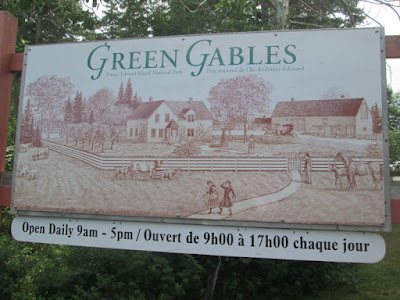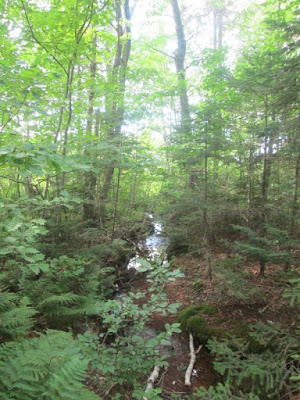I spent an afternoon exploring this farm and reliving the stories of Anne of Green Gables and the fictitious town of Avonlea. I felt the farm and the words of Lucy Maud Montgomery were as descriptive of Prince Edward Island today as they were to Avonlea in 1908.
In the late 1800s this farm belonged to David and Margaret Macneill, cousins of Lucy Maud Montgomery's grandfather. As a girl, Montgomery often wandered through their woods and later she made the farm famous as the setting of "Anne of Green Gables", her best-loved work of fiction.
(Lucy Maud Montgomery)
The literary works of Island-born author, Lucy Maud Montgomery have achieved international acclaim. Her first book, Anne of Green Gables, was published in 1908.
(Lucy's grandparents, Lucy Woolner Macneill (1824-1911) and Alexander Macneill (1820-1898)
Lucy Maud Montgomery was born in New London, Prince Edward Island in 1874. She was raised by her maternal grandparents in Cavendish after her mother died of illness when Maud was 21 months old. Maud's father, unable to care for an infant, moved to Saskatchewan.
(Rev. Ewan MacDonald)
Lucy did not leave Cavendish permanently until after her grandmother's death in 1911, when she married the Rev. Ewan MacDonald and moved with him to Ontario to start their own family.
Anne of Green Gables is a fictitious story about a young orphan who is mistakenly sent to live with an aging brother and sister, Matthew and Marilla Cuthbert, on their farm called Green Gables.
The story is set in rural Prince Edward Island in the late 1800s and its heroine, Anne Shirley, is a red-haired, freckle-faced girl--full of imagination and spirit--who despite her many misadventures soon endears herself to everyone in the imaginary village of Avonlea.
Lucy often visited the Green Gables house and it became the setting for her stories about Anne.
The house has been maintained and is now protected by the Province but the furnishings have been supplied by the townspeople of Cavendish.
The local people are so proud and protective of L.M. Montgomery and her stories that they have provided the furnishings for the house from their own attics and basements.
All of the furnishings in the farmhouse date to the period of the stories.
Great effort was taken to match the look and feel to the descriptions in the stories.
Lucy Maud Montgomery never lived in the Green Gables house. She was born in a smaller farmhouse a few miles away. Her grandparents house where she eventually lived was a mere 15 minute walk through the woods. That house no longer stands.
The Green Gables house is now one of the single most popular attractions in all of Canada.
It was particularly fun to watch the little pre-teen girls as they spied things in the house and on the grounds that reminded them of some part of the books. They would share with anyone near them that this scene or that adventure occurred in that spot.
This is the view looking from the front door of the house and it is completely like the countryside throughout Prince Edward Island.
The woods that stretched between the two farmhouses.
The Haunted Wood follows an easy 3/4 mile loop through the grove. Montgomery imagined these woods to be full of mystery, especially after dark, and lent the haunted wood to Anne and the other characters of Avonlea in "Anne of Green Gables.
"I am grateful that my childhood was spent in a spot where there were many trees...When I have lived with a tree for many years it seems to me like a beloved human companion." L.M.M.
In her early childhood, Montgomery had many spirited conversations with imaginary friends. She said they were 'real folk to my imagination'.
Look and listen carefully--In ferny dells with brooks slipping through them. Montgomery could almost believe in fairies...'You always just miss them...but their laughter floats back to you in the sudden whisper of the wind and the puckish rustle of the aspen. '
"As I walked up the Old Lane I would see the kitchen light shining through the trees. I would pass under the birches...and then around the curve. The old house would be before me." L.M.M.
(The foundation of her grandparents farm)
"I consider it a misfortune to love any place as I love this old homestead...the agony of parting from it is intolerable. I love this old home deeply, and I love Cavendish."
"Oh beloved old place..Have not old homesteads souls that cling to them until they crumble to dust?" L.M.M.
"...the incidents and environment of my childhood had a marked influence on my literary gift. Were it not for those Cavendish years I do not think "Anne of Green Gables" would ever have been written." L.M.M.
"The old house lay before me in silvery shadow. I turned aside for a moment to the old well and looked down it..." L.M.M.
"The peace and quiet of this dear old place is very sweet to me. There is no place on earth I love or ever will love as I do it." L.M.M.
"My garden...the delight it has been to me...I am positively reveling in flowers--dozens of the most lovely blossoms."
" It is the greatest pleasure my days bring to me to go out to my garden every morning and see what new blossoms have opened overnight." L.M.M.
"...the trees that whispered nightly around the old house where I slept, the woodsy nooks I explored, the homestead fields, each individualized by some oddity of fence and shape." L.M.M.
The woods below L.M. Montgomery's cousins' home inspired her descriptions of the hollow below Green Gables "where the brook ran and where scores of birches grew, upspringing airily out of an undergrowth of woodsy things."
Many of the places Montgomery described so lovingly are now preserved and protected for future generations in Prince Edward Island National Park.
Close to 500,000 visitors find their way to Green Gables each year.
In 1943, L.M. Montgomery was recognized by the government of Canada as a person of national historic significance.
(I found the entire series of Montgomery's books about Anne Shirley as Kindle ebooks on Amazon.com for the huge sum of ninety nine cents! Of course I bought them and just may have to reread them someday.)









































No comments:
Post a Comment